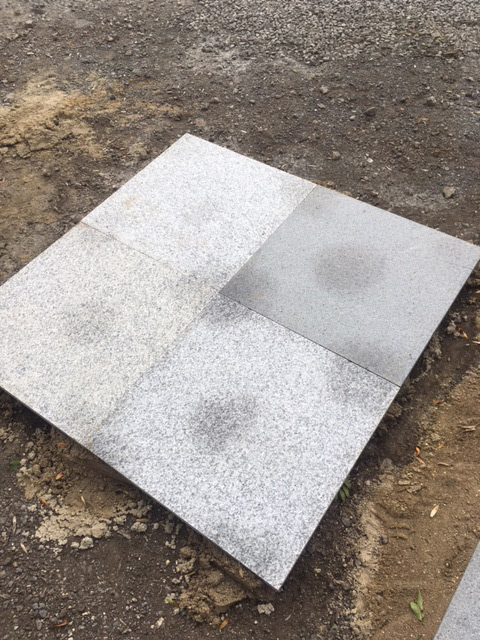This is a demo store. No orders will be fulfilled.
Guides for Installation of Paving
Laying Paving Slabs, Cobbles and Setts
Planning
Decide upon your paving and the number of sizes you require commensurate with your preferred laying pattern. Draw a scale plan on graph paper, outlining house, garden and the intended paved area and where possible adjust any perimeter edges to suit paving sizes to avoid unnecessary cutting. In differing colours per size draw in each slab to act as an ordering and laying guide. Arrange for all your paving requirements to be delivered before the onset of the project and stack nearby on a dry base.
Site Preparation
All paving should be laid on a firm, level and well-drained base to ensure long term service and stability - getting the ground work right is essential. Vegetation and top soil should be removed to an approximate depth of 200mm across the area to be paved. Mark out this area with pegs or retaining boards and adjust their height to the required finished surface levels, ensuring that you allow a fall of 1:60 away from any buildings and walls for surface drainage. Also make sure that the finished paving surface level is at least 150mm (two brick courses) below the level of any damp proof course.
After excavation, rake level to ensure an even depth and compact the whole area using a garden roller or tamper. Then lay at least a 75mm deep sub-base of crushed stone or hardcore and compact well (your local stockist will be able to advise you on a suitable material). If there are voids after compacting the sub-base, rake in sand and compact again. Spread a layer of sharp sand across the sub-base, to a compacted depth of 35mm.
The alternative is to have a wet mix of 4 parts sharp sand with one part cement, mixed to a consistency that is moist but not overly wet. Wet mortar can be messy. Light coloured flagstones, and those formed from granite are often prone to discolouration when laid onto mortars made using strongly-coloured sand, such as the orangey sands common in SE England. For these flagstones, we recommend that the laying mortar should be prepared using 6 parts neutral coloured sand (often sold as "Silver Sand") and 1 part white cement. This will minimise any risk of discolouration whilst ensuring your new paving is properly bedded and fully supported.
Laying
It is always preferable to start with full flags laid adjacent to a fixed point such as the house or boundary wall and to work towards an edge which may be adjustable. Alternatively start from a corner on the longest straight edge. If you are laying more than one size of paving, particularly if in a random pattern, or if you are laying a circle or other feature, it is recommended that you dry lay the flags first to check the fit and make sure you are happy with the pattern. For greatest stability the paving should be laid on a full mortar bed, using a wet mortar mix of 5 parts building sand to 1 part cement. This is essential if you are using one of the natural stone paving products. The majority of manufacturers advise that at lease a 3mm joint should be used on paving products. The joint is there for various reasons such as allowing jointing compounds to be used which need at least 3mm to adhere correctly and also to allow for slight expansion and contraction of the slabs in inclement weather conditions. There is information on every product page stating the recommended joint width.
See the below example as to why to use a full mortar bed as opposed to a few blobs. Moisture and minerals are sucked up through the slab in a sporadic way causing staining.
To ensure the slabs "stick" to the mortar bed it is recommended that SBR Bond is used on the underside of the slabs. It will act as a strengthening agent for concrete and natural stone surfaces, as an adhesion agent in bedding and pointing mixes, as a waterproofer for damp-susceptible paving stones, as a bond bridge for impermeable flagstones, as a primer/bonding agent for wall cladding and step risers.
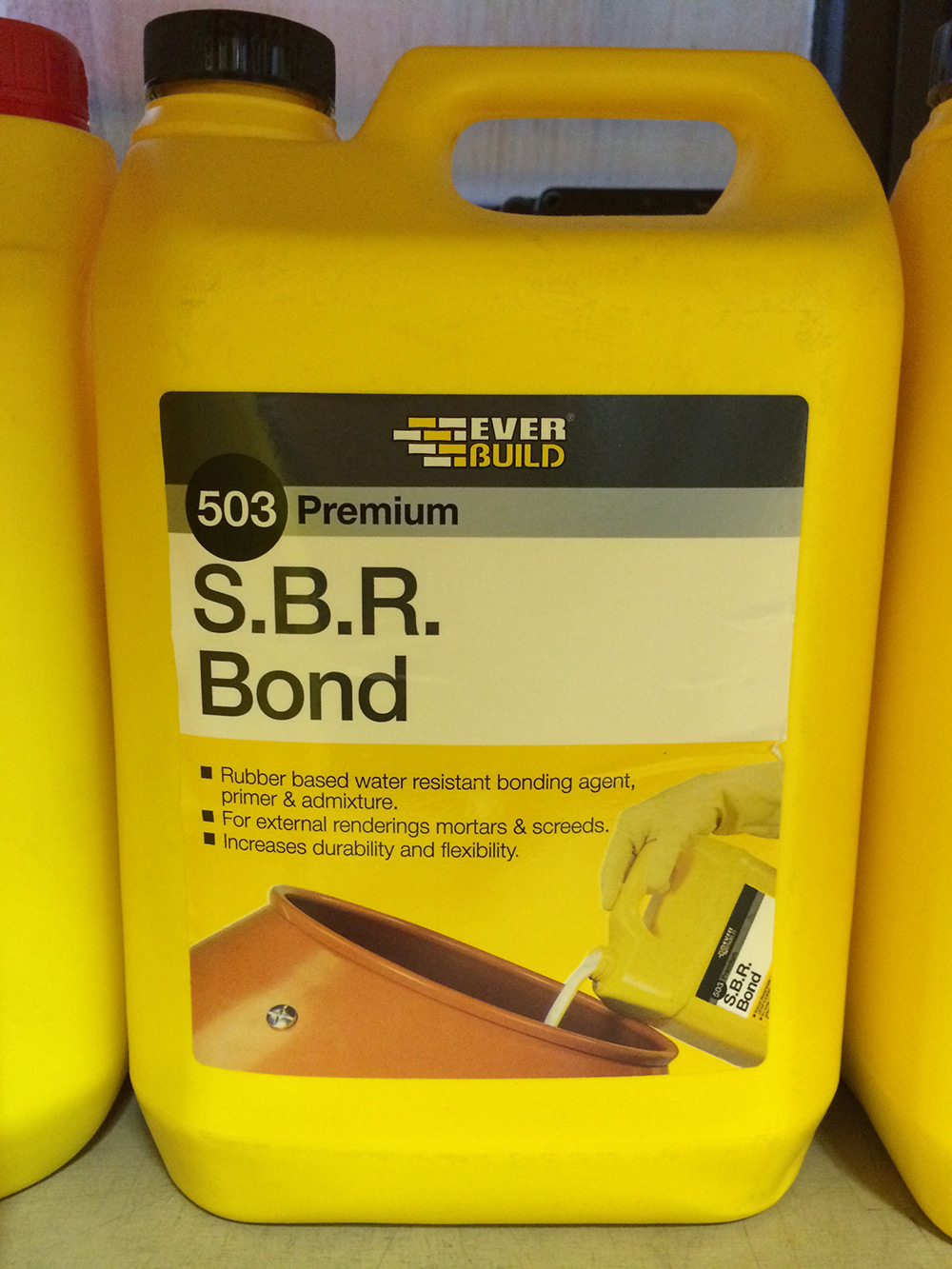
We advise that you take the paving from a number of open packs at once, even if you are just using one size, to ensure a consistent appearance to the finished patio.
Tap each paving stone down to the required level, keeping a piece of softwood between the hammer / mallet and flag (alternatively use a rubber mallet). Continually check levels and falls during the laying process across the top surface profile of a number of flags at a time. It is important to ensure correct spacing between the flags, although please note that for random patterns the joint widths can vary.
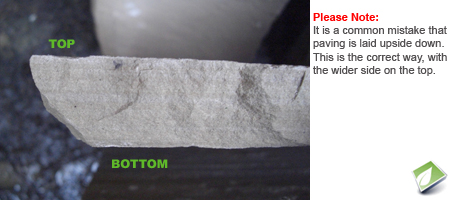
It is a common error that natural paving slabs are laid upside down, the image above shows the correct way to lay natural paving slabs.
Pointing can be completed as laying work progresses by "buttering" the sides of previously laid flags with mortar, and then smoothing or raking out the joints later when the mortar has started to set. Alternatively, the gaps may be pointed once laying is complete and the mortar is set using a semi-dry mortar mix of 6 parts building sand to 1 part cement. Take care not to stain the paving surface; any spillage should be removed immediately using a damp cloth or sponge. Do not attempt to brush the pointing mix across the surfaces of the flags as any cement left on the flag will result in unsightly staining.
A full mortar joint is recommended to ensure maximum surface water drainage and all joints should be smoothed or raked out using a suitable rounded piece of wood, a piece of pipe or a specialist pointing tool.
Manufactured reconstituted flag paving is suitable for domestic garden use only. It is not suitable for driveways or heavy traffic.
For driveways any of Domestic Block Paving, Natural Block Paving or Stone Setts (i.e. Sandstone, Limestone or Granite) may be used providing they are laid on a suitable sub base.
Romex Easy Pointing / Grouting Mortar


The easiest pavement fixing mortar. Suitable for frost and de-icing salt resistant, weed-free, abrasion-resistant, environmentally friendly, quick, cost-effective and permanent joint fixing of almost all natural and concrete paving stones, slabs and clinker surfaces.
Laying Setts and Cobbles
The area to be laid should be excavated to a depth of 200mm, removing any topsoil and vegetation and ensuring where applicable that falls slope away from buildings and walls with at least a 1:60 gradient. You should make sure that the finished surface level is at least 150mm below the damp proof course. Lay a minimum depth of 75mm compacted stone to cover the excavated area. Then lay a minimum depth of 100mm wet concrete bed foundation using 4 parts coarse aggregate to 2 parts building sand to 1 part cement.
Lay the setts on a 40mm compacted thickness of semi-dry cement mix (3 parts sand to 1 part cement) with a nominal joint width of 15-20mm. Bed the sets down with a pavior's maul and then fully compact (for large areas the hire of a plate vibrator is recommended). In dry weather and when the setts are dry fill the joints and pack firmly as the work proceeds with a semi-dry mix of 3 parts sand to 1 part cement, ensuring no pointing mix remains on the surface of the setts.
If no vehicular traffic is expected, the setts may alternatively be bedded on mortar laid onto existing firm and stable concrete surfaces or similar.
Laying Block Paving
Lay the MOT Type 1 Roadstone inside of the edge restraints and rake to the desired level in layers of 50mm. Level and compact using a vibrating plate. The roadstone should be at least 100mm thick after compaction. The vibrating plate should be passed over the area at least 7 times ensuring it’s thoroughly compacted.
Once this has been done, a layer of slightly damp sharp sand, to the depth of 50mm, needs to be applied and compacted with the vibrating plate. A second layer of sharp sand to a level of 20mm then needs to be applied on top of this. Using the string lines, screeding rails and straight edge, this second layer of sharp sand needs to be levelled to the correct falls
Always begin laying block paving from the bottom of a slope, preferably starting from a right angle or a straight edge. Place the blocks on top of the laying course ensuring blocks are around 45mm above the desired finished level. Continue with your desired pattern while making sure that you are using blocks from between 35 packs at once to minimise any colour banding. When the full blocks are laid, you will need to cut an amount of blocks to fill the smaller gaps. This can be done by using either the block splitter or the diamond disc saw. You should avoid making a cut block less than a third of its original size.
Sealing
Geofix Stone Protector
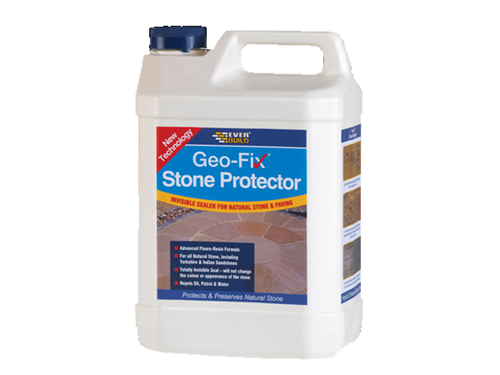
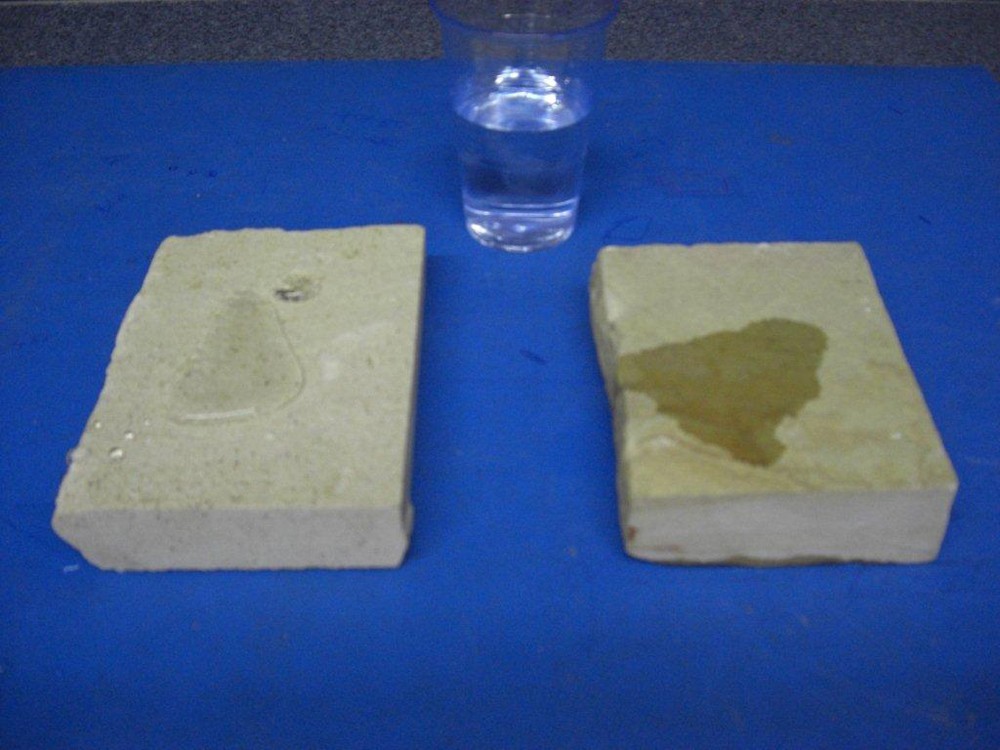
Based on an advanced Fluoro-Resin formula, Geo-Fix Stone Protector has been specially developed to provide highly effective long lasting protection on Natural Stone and Mineral Surfaces. Importantly, particularly when using on expensive high quality Natural Stone, Geo-Fix Stone Protector is totally invisible and will not change the colour or appearance of the stone.
Make sure paving is completely dry and free of efflorescence before applying any coating. Responsibility for the performance of any coating rests with the user and the manufacturer of the coating. Always read the instructions carefully and first test a small area for colour and slip resistance, wet and dry.
The paving should be clean, dry, free from dust, detritus and organic material (weeds, mosses, algae, etc). New paving should always be allowed to 'weather in' for at least 6 weeks before applying a sealant. Generally speaking, if there are to be any serious problems with new paving, they'll become apparent during those first few weeks.
Building Walls
Strip topsoil, dig to firm ground and lay level concrete foundations. As a rule of thumb a foundation should be dug approximately one third of the total wall/feature height (minimum depth 100mm) and foundation width should be three times the width of the wall. A recommended foundation mix would be 4 parts coarse aggregate to 2 parts building sand to 1 part cement. Stretch a building line between the ends and build one course at a time, checking for accuracy vertically, diagonally and horizontally using a spirit level. Using a trowel, spread mortar (4 parts building sand to 1 part cement) evenly over the foundations and then over the blocks in each course as you lay them; the mortar should just exude from between the joints and any surplus is taken off with the trowel. Don't forget to fill the vertical joints as you go by applying mortar to one end of the block before positioning it adjacent to the previously laid block. The blocks should be laid in a stretcher bond using half blocks at the end of each alternate course.
Using a pointing trowel, smooth and finish the mortar joints. Top with the required coping.
Please remember for retaining walls higher than 600mm and any wall built over one metre high, professional advice should be sought prior to construction.
If you are building a raised planter, barbecue or similar small garden feature on an existing concrete base or well laid patio, foundations may not be required.
Installing Edging
Whilst our edging range can be laid directly into the ground, for stability a more permanent method of fixing is recommended. This may be achieved by digging out a small foundation trench to the required length, approximately 100mm deep and 150mm wide. Fill and level with a foundation mix of 4 parts coarse aggregate to 2 parts building sand to 1 part cement.
Once the foundations have cured, bed the edging by gently tapping the top edge with a rubber mallet into a mortar bed of 4 parts building sand to 1 part cement, ensuring each unit is aligned and level. Back fill the reverse face of the edging with the same mortar mix "haunched" with a 45 degree wedge of mortar to a height that will be concealed by the finished surface.
Evenly space the stepping stones across the lawn or border. Using the stepping stone as a template, cut away the surrounding turf or soil to a depth of approximately 75mm. Infill with sharp sand to a depth of 35-40mm or use a weak semi dry mix of 5 parts sand and 1 part cement. Place stepping stone and tap down gently with a rubber mallet so that it sits just below the level of the lawn.
Using Decorative Aggregates
Clear the required area, removing all loose material and vegetation (use weedkiller if necessary on any deep-rooted weeds). Lay a semi permeable membrane over the whole area, with a minimum of 50mm overlap between sheets. Lay the decorative aggregate to the required depth (40mm is sufficient for most applications but check the packaging for any instructions specific to your product). Rake to achieve the required surface level. Although decorative aggregates can be laid directly onto soil it is recommended to use a membrane to minimise weed growth.
Maintenance / Cleaning
Regular maintenance is required to keep the overall appearance of the product in pristine condition. We recommend thoroughly washing paved areas with warm soapy water and brushing off with a stiff broom three or four times a year.
We cannot be held responsible for the possible effects or damage caused by the contamination or application of some chemically based products which come into contact with a concrete surface e.g. some weed killers and acid or alkali based cleaners.
Common salt should not be used to de-ice wet cast paving. To prevent possible surface damage always use a proprietary brand of de-icing product expressly formulated for use on concrete.
Sweeping
Regular sweeping with a broom will remove most of the usual litter and garden debris that finds its way onto all pavements. Occasionally, it can be beneficial to hose down the paving, adding a dash of basic detergent if required to help remove any surface stains. For sensitive paving such as limestone´s, many cleaning specialists prefer to use a mild baby shampoo in place of standard detergent as they believe this runs less risk of damaging the natural colouring of the stone. Scrubbing with soapy water and a stiff brush will help shift any awkward stains, but don't be tempted to use anything overly abrasive, such as steel wool or wire brushes as these can leave marks on the surface of your paving.
Power Washers
High pressure washers are not recommended for use on manufactured paving. Power washers can help clean heavily soiled paving but they should be used sparingly and with great care. They can damage the surface of the stone and/or the jointing if not handled correctly. If a power washer is to be used, we would strongly recommend the use of a ´rotary cleaning head´ rather than the more usual ´lance´ as these are less damaging to the paving while still being very effective against dirt. When power washing is used, it should be limited to one, and a maximum of two sessions per year. Patios and driveways that are power washed on a regular weekly or fortnightly basis tend to develop structural problems such as failed jointing, settlement and excessive surface wear of the paving.
Drainage
When laying a patio or path close to a house or dwelling it is essential that the finished paving surface is at least 150mm below damp course level and should slope away from the building. (A fall of 1:60 is generally sufficient). All paved areas should be gently sloping to allow excess water to be directed away and should always be laid on well drained ground. Any base preparation should also allow for drainage. Poor drainage may result in water retention and may affect the weathering characteristics of the materials.
Awkward Stains
For heavy staining, such as oil drips, autumnal fruits, bird droppings, etc., if basic cleaning using hot, soapy water does not work, we would recommend that you seek specialist advice from a surface cleaning professional. Many of the ´patio cleaners´ sold in DIY store or Builders Merchants are based on strong acids that can irreparably damage certain types of stone or adversely affect the natural colouring. Always test any cleaning product on a surplus flagstone or sett or in a discreet corner before applying it to the paving.
Efflorescence
Efflorescence is a problem more commonly associated with concrete paving, as the characteristic white powdery deposit originates in the calcium carbonate of the concrete, but it can also affect natural stone paving when it is laid on mortar or concrete. While the appearance of efflorescence can detract from the looks of a new pavement, it is important to understand that, no matter how bad it may seem, it is temporary, that it will pass with time, and that it is not actually damaging the stone. There are efflorescence removers that can be used to wash away the worst of any deposit, but they are removers, not cures, and it is quite likely that a new deposit will appear within a few days, although it may not be as heavy as the original deposit. Simple washing with warm soapy water will usually achieve the same, and at a much lower cost!
Sizing/Dimension Policy
All dimensions given are nominal and subject to manufacturing tolerances. The quoted dimensions of our paving ranges are those normally attained when the slabs are arranged correctly spaced.
The stated thickness of products are subject to manufacturers and suppliers tolerances. As a rule of thumb concrete/manmade products has a calibrated tolerance to + 1mm whereas natural products have a tolerance of + 3mm. If thickness is a major criteria then please contact a member of our sales team for further assistance.
Product Colour Variation
The colours depicted on this site are as accurate as modern photography and printing processes allow. Tonal variations are evident in all manufactured and natural stone products, we therefore recommend that colours are judged from actual materials. This is of significant importance when selecting a natural stone product which, by its very nature, each component will exhibit considerable deviations. It is important to view a range of samples to acknowledge the authentic diversity in colours, texture and markings.
Manufactured products are designed to simulate natural stone and naturally occurring aggregates are utilised, therefore variation between batches can occur. To produce a natural overall appearance when using two or more packs of product we suggest that individual products are drawn from each pack and mixed on site at the onset of the project.
Reconstructed stone products will weather in a similar way to natural stone, therefore the effect of the elements and site conditions may cause some colour change dependent on the degree of exposure. After laying, some natural stone products may exhibit a brown colouration when oxidation of any iron content occurs.
When using several packs, products from all the packs should be blended throughout the project to produce an acceptable overall natural appearance. Always order enough material to complete the project and ensure that you mix the products from all packs during installation. It is essential that you examine each piece prior to laying as Landscaping Supplies Direct will not accept responsibility for any costs associated with uplifting or relaying of products if any fault is discovered within the paving after installation.
Laying Patterns
Please click the following link: http://lsd.co.uk/patio-layout-guides
Stonemarket offer a fantastic version of their Paving Generator now on their website so you dont even have to download and install it. Just follow the link to design your patio in minutes. http://www.stonemarket.co.uk/paving-generator/
Safety Advice (Unpacking of Goods)
Care must be taken to ensure goods are unpacked in a safe way. Goods on a slope should be assessed for stability before removal from crates, packs or bags. Landscaping Supplies Direct does not accept any liability for any accident that may occur whilst goods are being unpacked. The use of gloves and eye protection is advisable when unpacking sharp or dusty items. Care should be taken when cutting bands as they are under extreme tension and can cause injury if not cut correctly. If the pack is leaning, it is advised that a piece of timber be used to prop the slabs or pack to prevent them from falling when the packaing is removed.
LSD recommends using a “Full Wet Bed” approach to installing porcelain paving. This method is advocated by several industry leading suppliers, it uses recognised techniques applied by landscaping professionals and is the most efficient way of installing porcelain flags.
The Full Wet Bed method requires the careful placement of the flags onto a levelled out bed of sand/cement mortar, this should be prepared to a wet consistency. The mortar bed should be at least a 6:1 (or stronger) mix of grit sand and cement, and should be placed on a prepared base. We have found that most landscapers use a 25-40mm thickness to ensure a bed with adequate depth to create a layer that is able to support itself and the paving. Using a sub-base (or base) is vital, failure to do so may result in the whole area of paving failing in the short term. Applying a slurry primer to the base of the paving slabs is also essential, we recommend using Instarmac Pro-Prime Slurry Primer.
As with any other paving, using joint spacers will enable a regular joint width to be maintained. Using spacers will also reduce the risk of movement when laying, therefore keeping edges neat and tidy. To ensure the tiles are consolidated down to the correct levels, the receiving bed should be accurate but high enough to accept the tiles and allow for tapping down. When tapping down, ensure a ample proportion of the paving is in direct contact with the concrete base. A soft mallet should be used for tapping down; porcelain paving is strong but a heavy blow from a hammer is likely to cause breakages.
CUTTING PORCELAIN PAVING
It is highly likely that at some point your porcelain paving will need to be cut. When cutting there is only one suitable method: a powered cut-off saw fitted with a good quality diamond blade. We have found the best type of blade to use is a high quality continuous rim diamond blade specifically for cutting porcelain tiles. Standard abrasive cutting discs will caused chipping and cracking of the paving. Before cutting, have the line clearly marked and have the blade rotating at half-revs before making contact with the paving. The blade should also we water fed for dust suppression, we strongly advise this as the dust generated is potentially carcinogenic. As the blade bites into the tile, increase the revs if necessary, ensure the saw remains evenly balanced and cuts along the line at a steady pace.
For jointing, we recommend using narrow joint, two-part epoxy resin such as Rompox D1 for a quick, clean and reliable joint finish. You do not have to worry about frost damage or washing out of joints, as all D1 products are frost and de-icing salt resistant. In addition, weeds are no longer able to take hold, thus ensuring a permanently visually attractive jointed surface.


